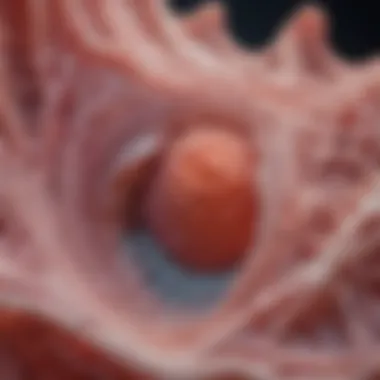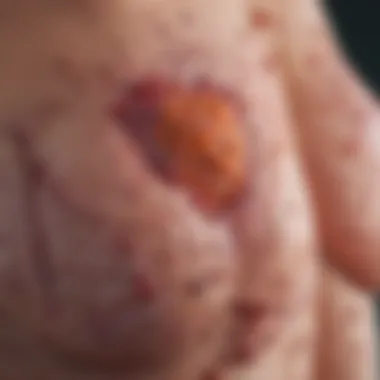Understanding Scattered Fibroglandular Elements in Breast Imaging


Intro
Breast imaging plays a crucial role in the assessment of breast health. Among the complex components observed in various imaging modalities, scattered fibroglandular elements are particularly significant. Understanding these elements is essential for both medical professionals and patients navigating breast health concerns.
Scattered fibroglandular elements represent a mix of glandular and fibrous tissue within the breast. Their presence can affect breast density calculations, which are important for evaluating breast cancer risk. In this article, we will explore these elements comprehensively, concentrating on their significance within the context of breast imaging.
This analysis will highlight the latest advances in imaging techniques, as well as the methodologies used to study these tissue compositions. Through this examination, we aim to provide clear insights into the diagnostic implications and recommendations for further evaluation of scattered fibroglandular elements.
Recent Advances
Recent years have seen substantial progress in the understanding of scattered fibroglandular elements, propelled by both innovative research and technological advancements.
Latest Discoveries
Research has established that the density of fibroglandular tissue in the breast can be a significant indicator of cancer risk. Studies are showing correlations between higher densities and increased risk of breast cancer, underscoring the importance of understanding how these elements function within breast tissue. Furthermore, findings indicate that not all fibroglandular tissue behaves similarly, prompting further studies to differentiate between types and their respective risks.
Technological Innovations
Advancements in imaging technology, such as Magnetic Resonance Imaging (MRI) and Contrast-Enhanced Mammography, have improved detection rates of fibroglandular elements. These technologies allow for a more detailed view of breast tissue composition, enhancing the clarity and accuracy of diagnoses. These innovations are valuable not just for diagnoses but also for monitoring changes in breast density over time and evaluating the efficacy of treatment options.
Methodology
An understanding of methodology is crucial for grasping how research is conducted in this field. Various designs and techniques ensure reliability and depth of findings.
Research Design
Most studies related to scattered fibroglandular elements utilize longitudinal observational designs. This approach helps track changes in breast tissue over time and can yield insights into how these elements may influence health outcomes such as cancer risk.
Data Collection Techniques
Data is collected through imaging studies, most commonly using mammograms followed by follow-up imaging such as ultrasound or MRI. Additionally, patient history and tissue density analyses contribute to a comprehensive understanding of the implications of fibroglandular elements. Gathering this information aids in establishing a clearer link between tissue composition and its clinical relevance.
Understanding the role of scattered fibroglandular elements in breast health is essential for accurate risk assessment and effective patient care.
As we progress further into this topic, inviting the audiences' inquisitive minds to explore and comprehend the integral role these elements play in breast imaging is our goal. The need for clarity and depth in understanding scattered fibroglandular elements is vital in the realm of breast health.
Foreword to Fibroglandular Elements
Understanding scattered fibroglandular elements is essential in the realm of breast imaging. These elements represent a critical aspect of breast tissue composition, which can influence diagnostic accuracy and patient management. With the advent of advanced imaging technologies, the ability to identify and interpret scattered fibroglandular components has become increasingly crucial for healthcare professionals.
This section aims to lay the groundwork for a deeper exploration of the role these elements play in breast density assessment, their implications for health, and the significance they hold in radiological evaluations. The analysis of scattered fibroglandular elements offers insights into patient screening processes and the potential risks associated with variations in breast tissue density.
Definition of Fibroglandular Elements
Fibroglandular elements are specialized components within breast tissue, composed primarily of connective and glandular tissues. The connective tissue, which includes collagen and adipose (fat) tissue, provides a structural framework. Meanwhile, glandular tissue is responsible for milk production. This combination is vital for the overall function and health of the breast.
The expression of fibroglandular tissue can vary significantly among individuals. It may be influenced by age, hormonal changes, and genetic factors. Understanding these variations is key in evaluating breast density, which can impact screening outcomes and risk assessments for breast cancer.
Composition and Structure of Breast Tissue
Breast tissue consists predominantly of adipose tissue and fibroglandular tissue. Adipose tissue comprises a large portion of the breast and serves as an energy reserve. In contrast, fibroglandular tissue, although less abundant, is crucial for the physiological functions of the breast.


The structure of breast tissue has a complex architecture. It includes:
- Lobules: These structures contain the milk-producing glands.
- Ducts: These are pathways that transport milk to the nipple.
- Stroma: This supportive tissue includes blood vessels and connective tissues that support lobules and ducts.
The ratio of fibroglandular to adipose tissue determines breast density. Higher levels of fibroglandular elements correspond to denser breast tissue. This density can impede the detection of abnormalities during imaging, which necessitates careful evaluation through techniques such as mammography, ultrasound, and MRI.
The relationship between fibroglandular tissue and breast density is critical in identifying individuals who may need more rigorous screening protocols.
Overall, understanding fibroglandular elements is important for interpreting breast imaging results accurately and making informed decisions regarding patient care.
Role of Scattered Fibroglandular Elements
Scattered fibroglandular elements play a crucial role in breast imaging. These elements are a mix of fibrous and glandular tissues within the breast, which can significantly affect how imaging results are interpreted. Understanding these components is essential for providing accurate diagnoses and optimal patient care. Their presence can influence the visibility of lesions or masses during imaging examinations, highlighting the need for awareness among healthcare professionals.
Importance in Breast Imaging
The importance of scattered fibroglandular elements in breast imaging cannot be overstated. Radiologists must be able to distinguish between these elements and potential abnormalities. Their density is a vital factor in mammography. A higher concentration of fibroglandular tissue can mask tumors, making them difficult to detect. This scenario emphasizes the importance of tailored imaging techniques for different breast types, especially for women with denser breast tissue.
Furthermore, studies indicate that denser breast tissue may be associated with a slightly elevated risk of developing breast cancer. Recognizing areas occupied by these fibroglandular components can not only help in proper diagnosis but also guide subsequent steps in management or treatment. Thus, the role of scattered fibroglandular elements extends beyond mere imaging; it plays a part in risk assessment and guideline formulation tailored to individual patient needs.
Indicators of Breast Density
The presence of scattered fibroglandular elements serves as a primary indicator of breast density. Breast density is an important aspect considered in imaging practices. It can categorize breast tissue into four categories:
- Mostly fatty tissue
- Some glandular and fibrous tissue
- Dense glandular and fibrous tissue
- Extremely dense breast tissue
Understanding these categories helps in evaluating cancer risk effectively. Numerous studies have linked dense breast tissue with an increased likelihood of breast cancer. The reasons behind this correlation are still being explored but are believed to involve a combination of biological and hormonal factors.
In clinical practice, identifying the degree of breast density allows healthcare providers to consider supplementary imaging techniques when necessary, such as ultrasound or MRI, for patients with denser breast tissue. This aspect of patient management not only optimizes cancer detection but also personalizes care based on individual risk factors.
"Breast density is a significant radiological finding that influences screening and diagnostic pathways."
Accurately assessing breast density through the visibility of scattered fibroglandular elements is important in developing personalized screening strategies. Overall, the implications of identifying and interpreting these elements in imaging bear substantial consequences for both diagnosis and patient outcomes.
Diagnostic Techniques
Diagnostic techniques are crucial in the assessment of scattered fibroglandular elements in breast imaging. They provide essential tools for effectively evaluating breast density, identifying potential anomalies, and developing comprehensive management strategies for patients. Such techniques help to elucidate the complexities surrounding breast tissue composition and its implications for breast health.
Mammography Methods
Mammography remains a cornerstone in breast imaging. It offers high sensitivity in detecting irregularities in breast tissue, especially in women with dense breast tissue.
- Standard Mammography: Traditional 2D mammography uses X-rays to capture images of the breast. This method can reveal structures and densities, allowing for the identification of areas with scattered fibroglandular elements. However, its effectiveness diminishes in denser breast tissues, which may obscure tumors.
- Digital Mammography: A more modern approach, digital mammography provides enhanced contrast and allows for better visualization of fibroglandular structures. The digital format facilitates image manipulation, aiding radiologists in their diagnostic processes.
- Tomosynthesis (3D Mammography): This technique involves taking multiple X-ray images of the breast from various angles. The result is a three-dimensional representation that significantly improves the detection of breast lesions, especially in the presence of scattered fibroglandular tissue. The 3D images can help distinguish between overlapping structures, making it easier to identify abnormalities.
Ultrasound Examination
Ultrasound serves as an adjunct to mammography, particularly in women with dense breast tissue. It utilizes sound waves to create images of breast structures.
- Benefits of Ultrasound: Ultrasound helps differentiate between solid masses and cystic formations. This is particularly useful in assessing areas of concern flagged during mammography.
- Limitations: However, the operator-dependent nature of ultrasound can introduce variability in results. Additionally, small lesions may be missed, emphasizing the need for a combination of imaging modalities for accurate assessment.
MRI Utilization in Breast Imaging


Magnetic Resonance Imaging (MRI) plays a vital role, especially in high-risk populations. It offers unparalleled detail in visualizing breast tissue.
- High Sensitivity: Breast MRI is more sensitive than mammography and ultrasound, capable of detecting small invasive cancers that may be obscured by dense tissue.
- Functional Imaging: MRI not only visualizes structure but also functional dynamics through contrast enhancement, providing insights into the vascularity of lesions.
- Recommendations for Use: Guidelines typically recommend MRI for women with a familial risk of breast cancer or for further evaluation of complex cases identified through other imaging techniques.
MRI provides vital insights into breast health, playing a significant role in early detection and accurate diagnosis.
In summary, utilizing a combination of mammography, ultrasound, and MRI enhances the diagnostic accuracy when evaluating scattered fibroglandular elements in breast imaging. Each technique offers specific advantages and limitations, which necessitate a tailored approach based on individual patient characteristics.
Implications of Density in Breast Health
The presence of scattered fibroglandular elements has significant implications in assessing breast health. Understanding the structure and distribution of these elements can aid in evaluating breast density, which is a crucial factor in breast imaging. Breast density is recognized as a vital criterion in cancer risk stratification and screening recommendations.
Breast density refers to the proportion of fibroglandular tissue to fatty tissue in the breast. High breast density can obscure the visualization of tumors on mammograms, complicating early detection of breast cancer. For this reason, patterns of fibroglandular tissue are important not just for imaging sciences but also for patient management and risk assessment.
Correlation with Cancer Risk
Numerous studies suggest a positive correlation between breast density and the risk of developing breast cancer. Women with high breast density are at a higher risk for breast cancer compared to those with less dense breasts. This connection is thought to arise because dense breast tissue might harbor undetected malignancies, making them harder to diagnose. Furthermore, the biological behavior of dense tissues could lead to more aggressive cancers.
Women with high-density breasts are recommended to engage in more vigilant screening strategies. Such strategies may include utilizing supplemental imaging techniques like MRI or ultrasound, especially when traditional mammography may not present clear results.
Guidance on Cancer Screening Recommendations
Screening guidelines often take breast density into account, highlighting the need for personalized evaluations. Dense breast tissue can affect how often and what type of imaging a woman may need. It is essential that healthcare providers tailor their recommendations based on individual breast density assessments.
For instance, women with extremely dense breasts may benefit from starting mammography screenings at an earlier age compared to those with less dense tissue. Furthermore, they may require adjunct imaging modalities to improve cancer detection rates.
"Understanding breast density is essential for providing effective screening strategies, ensuring that women are monitored appropriately based on their individual risk factors."
Beyond personal health implications, awareness of breast density fosters discussions surrounding legislation and public health initiatives. Some regions mandate that women are informed of their breast density and its association with cancer risk. This awareness empowers patients to participate actively in their health decisions, facilitating timely conversations with their healthcare providers.
Patient Management and Follow-Up
Understanding the presence and effects of scattered fibroglandular elements in breast imaging is vital for patient management and follow-up strategies. These elements can influence both the interpretation of imaging results and the overall clinical approach to breast health. Management practices must take into account the implications of fibroglandular density when determining individual patient risk profiles and follow-up needs. By using informed strategies, healthcare professionals can enhance patient outcomes significantly.
Strategies for Monitoring
Monitoring patients with scattered fibroglandular elements involves a structured approach integrating imaging findings and risk assessment. Key strategies include:
- Regular Imaging: Patients should follow a schedule of regular mammograms or ultrasounds. The frequency often depends on personal risk factors, including family history and age.
- Clinical Evaluation: Healthcare providers must conduct thorough clinical evaluations that include patient history and physical examinations. Evaluating changes in breast tissue can help identify potential health issues early.
- Patient Education: Providing patients with education on breast self-exams and awareness of changes in breast tissue is crucial. Patients should be encouraged to report any unusual symptoms promptly.
- Customized Screening Plans: Each patient’s screening plan should be tailored to their specific risk profile. Those with dense breast tissue may benefit from additional imaging modalities like MRI, which can provide clearer insights.
These strategies not only ensure ongoing surveillance but also empower patients with knowledge about their breast health.
When to Consider Further Evaluation
Deciding when to pursue further evaluation in patients with scattered fibroglandular elements is a delicate process. Several indicators can guide practitioners in making these decisions:
- Persistent Density Changes: If imaging studies reveal new or increased density, a thorough investigation is warranted. Continuous monitoring of density patterns helps in identifying changes over time.
- Clinical Symptoms: The appearance of new clinical symptoms, such as palpable masses or unusual changes in the breast, should prompt further evaluation regardless of imaging results.
- Abnormal Imaging Results: If mammography or ultrasound reveal atypical findings, additional tests must be conducted to elucidate the context. This may include MRI or consultative evaluations with breast specialists.
- Family History of Breast Cancer: Strong familial predispositions can necessitate more vigilant follow-up and screening processes. It is essential to consider history in standard assessment protocols.
As stated by the American College of Radiology,
"Timely follow-up of suspicious findings can significantly enhance early detection of breast cancer, ultimately improving outcomes."


Healthcare professionals must rely on a combination of clinical judgment and established guidelines when deciding on follow-up. The interplay between individual patient history and imaging findings shapes the pathway for responsible patient management.
Scientific Literature Review
The significance of reviewing scientific literature lies in its comprehensive nature. It provides a context for understanding current findings and theories surrounding scattered fibroglandular elements in breast imaging. This section serves as a bridge between empirical research and practical application within clinical settings. By synthesizing diverse studies, professionals can discern patterns, validate methodologies, and identify gaps in knowledge that may spur future research. The evolution of our understanding of breast density and related health implications is deeply interlinked with how research has progressed over time.
Studies on fibroglandular tissue describe its variation across different populations and how this factor can affect imaging techniques and results. Such research has enhanced our ability to interpret density classification in breast imaging, promoting a tailored approach to patient care. Thus, this review is crucial for fostering an evidence-based practice in breast health management.
Recent Studies on Fibroglandular Tissue
Recent research on fibroglandular tissue focuses on its correlation with breast density and the implications for cancer risk. For instance, a study published in the Journal of Computer Assisted Tomography indicated that a higher density could be associated with more complex imaging interpretations. This complexity has been linked to missed diagnoses and delayed treatments, emphasizing the vital role of accurate interpretation.
Another noteworthy study in Breast Cancer Research and Treatment analyzed the anatomical distribution of fibroglandular tissue using MRI techniques. The findings highlighted how variations in density could influence screening protocols. Furthermore, associations were drawn between high glandularity and the potential for aggressive tumor types, reinforcing the necessity for vigilant monitoring of dense breast patients.
Historical Perspectives on Breast Density Research
Historically, the perception of breast density and its relevance to health outcomes has evolved. Early research primarily focused on the dichotomy of dense versus fatty breast tissue, with little attention given to the subtleties within breast structure. It was not until the late 20th century that studies began acknowledging fibroglandular elements as significant contributors to breast density assessments.
Initial guidelines set by the American College of Radiology in the 1990s marked a turning point. These guidelines began to categorize breast density into distinct levels, allowing practitioners to evaluate risk more effectively. Over time, as imaging technologies progressed, researchers increasingly recognized the multifaceted nature of breast tissue composition. This historical perspective not only sheds light on how our understanding has changed but also highlights the ongoing dialogue in the scientific community about the best practices for breast imaging.
Future Directions in Research
The understanding of scattered fibroglandular elements in breast imaging is an evolving field. This section emphasizes the importance of continuing research. As technology advances and our comprehension of breast tissue dynamics improves, future investigations will be critical in refining imaging techniques and related clinical practices. These developments aim to enhance diagnostic accuracy and patient care.
Emerging Technologies in Breast Imaging
Emerging technologies in breast imaging represent a substantial advance over traditional methodology. Techniques such as digital breast tomosynthesis, also known as 3D mammography, show promise. They could help in discerning small lesions that may be obscured in standard 2D images. The increased sensitivity and specificity offered by these new methods result in better detection of both benign and malignant lesions.
Additionally, advanced MRI techniques, like diffusion-weighted imaging, provide insights into the cellular structure of tissues, enabling assessment that goes beyond standard imaging routines.
There is also ongoing research into artificial intelligence (AI) and machine learning algorithms that analyze imaging data. These systems can aid radiologists by flagging potential anomalies which may require further investigation, enhancing the efficiency of breast cancer screening processes.
"The integration of AI into breast imaging creates an opportunity to improve diagnostic outcomes and streamline workflows in clinical practice."
Potential Changes in Screening Guidelines
As new data emerges regarding the correlation between fibroglandular density and breast cancer risk, screening guidelines are also likely to evolve. Current standards emphasize individualized risk assessments based on genetic and familial history, but research could lead to more nuanced recommendations.
Future guidelines may take into account:
- The density of breast tissue when deciding appropriate screening intervals.
- Targeted screening approaches for patients with denser breast tissue, which may include supplemental imaging methods.
- Tailoring recommendations per age, family history, and ethnical background of individuals.
A comprehensive reevaluation of existing screening practices will become essential as the implications of breast density on health outcomes become clearer. Regular updates and continuous revisions will be required to keep pace with scientific advancements and ensure optimal patient care. By aligning screening protocols with emerging evidence, healthcare providers can enhance early detection of breast cancer while continuing to decrease false positive rates.
Culmination
The conclusion serves as a crucial section in the discussion of scattered fibroglandular elements in breast imaging. Through a collective analysis of prior sections, it synthesizes key insights and emphasizes their importance for both healthcare providers and patients. An understanding of these elements not only aids in accurate diagnosis but also underscores the broader implications for breast health.
Summary of Key Points
- Definition and Composition: Scattered fibroglandular elements represent varying densities within breast tissue that can significantly affect imaging results. Their understanding forms the base for interpreting various diagnostic techniques.
- Impact on Cancer Risk: Studies indicate a correlation between fibroglandular density and breast cancer risk, making awareness of these factors essential for effective screening and management strategies.
- Diagnostic Techniques: Techniques such as mammography, ultrasound, and MRI play indispensable roles in evaluating fibroglandular structures. Each medium brings distinct advantages and constraints that influence patient outcomes.
- Future Research Directions: Emerging technologies and potential modifications in screening guidelines reflect ongoing advancements in understanding breast density's clinical relevance and its implications for patient management.
Final Thoughts on Breast Imaging Practices
Integrating knowledge of scattered fibroglandular elements into daily imaging practices is vital. As research in this domain continues to evolve, it is imperative that practitioners remain vigilant about updates in imaging technology and related guidelines. By doing so, they can better serve their patients, ensuring that the assessment of breast density is both accurate and reflective of current scientific data. A commitment to continual learning and adaptation in breast imaging approaches will enhance patient safety and health outcomes in significant ways.
"Breast imaging practices must adapt and evolve with ongoing research for the best patient care."
Understanding scattered fibroglandular elements constitutes a key aspect in refining clinical practices. With comprehensive knowledge, medical professionals can enhance diagnostic accuracy and contribute to strategic management of breast health.















